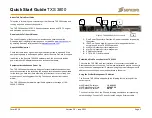
10
Version 2.1
Update: April 2016
PONSEL Mesure
– Aqualabo Contrôle
35 Rue Michel Marion
– 56850 CAUDAN, FRANCE
Tel.: +33(0)2 97 89 25 30
– Fax: +33(0)2 97 76 55 72
2.2.5 C4E sensor: 4-electrode conductivity.
The operation of the sensor is based on 4-electrode conductivity technology: an alternating current at
constant voltage is set up between a pair of graphite primary electrodes. The secondary electrodes,
made from platinum, adjust the drive potential at the primary electrodes to compensate for any fouling.
The voltage measured between the primary electrodes varies depending on the resistance of the
medium, and thus the conductivity.
Measurements
Measurement principle
4-electrode type conductivity sensor (2 gr
2 platinum).
Conductivity measurement range
0 - 200.0 µS/cm
0 - 2,000 µS/cm
0.00 - 20.00 mS/cm
0.0 - 200.0 mS/cm
Resolution
from 0.01 to 1, depending on the range
Accuracy
+/ 1 % of full scale
Salinity measurement range
5-60 g/kg
TDS-KCl range
0
– 133,000 ppm
Response time
< 5 s
Operating temperature
0 °C to 50 °C
Temperature compensation
Via an NTC thermistor
Storage temperature
- 10 °C to + 60 °C
Signal interface
Modbus RS-485 as standard and SDI-12 as an
option
Measurement refresh rate
< 1 second maximum
Power supply for sensor
5 to 12 volts
Power consumption
Standby: 25 µA
When sending via RS-485 (1 measurement/second):
6.3 mA
When sending via SDI-12 (1 measurement/second):
9.2 mA
Current pulse: 500 mA
Sensor
Dimensions
Diameter: 27 mm; Length not including cable:
177 mm (not including temperature sensor)
Weight
350 g ( 3 m of cable)
Materials in contact with the medium
PVC, POM-C, stainless steel
Maximum pressure
5 bar
Cable/connection hardware
9-wire shielded conductor, uncoated-strand
polyurethane sleeve
Ingress protection rating
IP68











































